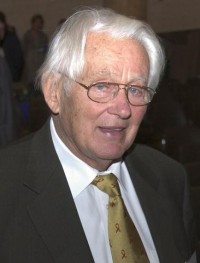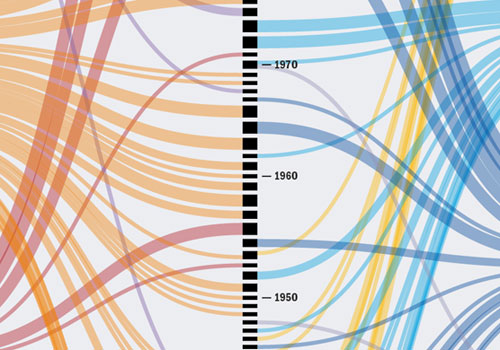By Hamish Johnston
Update on 16 October 2014: The 2014 prize has been added to the infographic.
At 11.45 a.m. CET (at the earliest) on Tuesday 7 October, the winner(s) of the 108th Nobel Prize for Physics will be announced in Stockholm. Like just about everyone else, I have no information about who will win – although I do have my suspicions (more on those tomorrow).
Predicting the future is never easy, but help is at hand with a new infographic that Physics World has created charting the history of the physics Nobel by discipline. Using the categories that we apply to articles on physicsworld.com, we have split the 107 prizes since 1901 into seven categories. If you click on the image above, you can see the infographic in all its glory.
The most popular discipline with Nobel committees through the ages is nuclear and particle physics, which accounts for nearly one-third of the prizes. As well as dominating the prizes in the 1950s and 1960s, nuclear and particle physics spreads its tentacles from the very first prize – to Wilhelm Röntgen for the discovery of X-rays – to last year’s prize, which went to François Englert and Peter Higgs for predicting a much more esoteric boson.
Interestingly, that very first prize in 1901 flags up an important challenge I faced while categorizing the prizes using contemporary disciplines. You could argue that when Röntgen discovered X-rays, he was doing atomic physics. Indeed, some of those X-rays would have come from atomic processes, while others would have been bremsstrahlung – which I would consider particle physics. However, because Röntgen accelerated electrons into a target and analysed the radiation produced, I decided that it was a particle-physics experiment.
What else can we learn from the infographic? One striking observation is that while today condensed-matter physics is a vast enterprise, it didn’t get a look-in until 1913, when Heike Kamerlingh Onnes won for his low-temperature studies and for producing liquid helium. And unlike nuclear and particle physics, there is no “golden era” of condensed-matter physics, with prizes spread out evenly since 1913.
Astronomy, astrophysics and cosmology arrived on the scene even later: in 1936, in fact, when Victor Hess shared half the prize for his discovery of cosmic rays. Researchers in the field had to wait until 1967 for their next prize, when Hans Bethe won a Nobel gong for his work on stellar nucleosynthesis, although in every decade since then at least one further prize has been awarded to those who study the heavens.
One very interesting trend that gets going around 1980 is that the prizes appear to be alternating between five categories. Does this mean that in the past 35 years or so, Nobel committees have made an effort to spread prizes across disciplines? If that’s the case, the infographic suggest that in 2014 we are due a winner from atomic, molecular and optical physics.

Georges Charpak is the last solo laureate. (Courtesy: CERN)
Turning to the number of laureates per prize (denoted by the thicknesses of the coloured lines and timeline markers), it is clear that shared prizes have become more prevalent since about 1950. Perhaps this is recognition that most science is a collaborative process, or perhaps that physics has become so complicated that a major breakthrough can’t be achieved by one person alone. The last two solo prizes came over two decades ago, when the French physicists Pierre-Gilles de Gennes and Georges Charpak won in 1991 and 1992, respectively.
The category with the highest average number of laureates per prize (2.25) goes to astronomy, astrophysics and cosmology, which could reflect the fact that all but one of the prizes in this field were awarded after 1950, when multiple laureates dominate. Quantum physics and classical physics are both just shy of one laureate per prize, which probably reflects the fact that most of these prizes were awarded before 1950 when the trend of sharing prizes began. Overall, the number of laureates per prize is a little over 1.8.
Finally, the strangest prize that I came across while compiling the infographic is the 1908 award, which went to Gabriel Lippmann “for his method of reproducing colours photographically based on the phenomenon of interference”. Lippman was a French physicist and his photography technique was so difficult to perform that it never made it out of the lab and was quickly overtaken by more practical colour processes. Even the Nobel committee sometimes get their judgements wrong.
NB Astute readers will notice that the infographic does not illustrate the fact that the prize has been shared by three winners in two different ways: three one-third prizes or one half prize and two quarters. We struggled with finding a way of showing this, but in the end decided that this distinction was not important in terms of understanding the temporal trends in disciplines and number of laureates that we are trying to illustrate.

An interesting analysis, but I have some reservations about the methodology. For instance, why group the first three prizes in the nuclear and particle physics category?Physicists did not recognize the nucleus until 1911 and x-rays became just as, perhaps more relevant to condensed matter and optical physics than they became for nuclear and particle physics. A very good argument can also be made that these and other early prizes for radiation phenomena fit better in the the atomic and molecular category. No one self-identified as a nuclear physicist or particle physicist until much later in the century. Also, why break off applied physics into a separate category, when the discoveries in question often fit neatly into one of the other topical categories? The 1956 prize for the transistor, for instance, was a watershed moment for American solid state physics.
In short, the categorization scheme tends to overestimate the nuclear and high energy share and underestimate the condensed matter/optical/atomic and molecular share.
Thanks for your comments, which nicely encapsulate many of the problems that I had classifying prizes that were given before about 1925.
A good example is Einstein, who won the 1921 prize “especially” for his insights into the photoelectric effect. I called this quantum physics, despite the fact that quantum physics didn’t exist when the work was done in 1905. Indeed, it’s safe to say that quantum physics had yet to be fully formed in 1921 when the prize was given! Nevertheless, we look back on Einstein’s photoelectric work as a seminal moment in the development of quantum physics.
Regarding the transistor, I did originally put that Nobel in condensed matter. But then I did a bit of digging and came to the conclusion that Bardeen, Brattain and Shockley were trying to create a practical device, so I popped it into applied physics.
I had toyed with splitting such prizes, so the transistor would be half applied and half condensed-matter — but that got very messy!
Trackback: Physics Viewpoint | What type of physics should you do if you want to bag a Nobel prize?
According to an obituary, written by Steven Chu, Arthur Schawlow used to encourage a young graduate by saying: you need not know whole physics but you must know that physics which is not known to others. This is can be a really useful advice.
A Nobel is wonderful, but awards to all that transfer knowledge and truth.
Trackback: Blog - physicsworld.com
Trackback: Blog - physicsworld.com